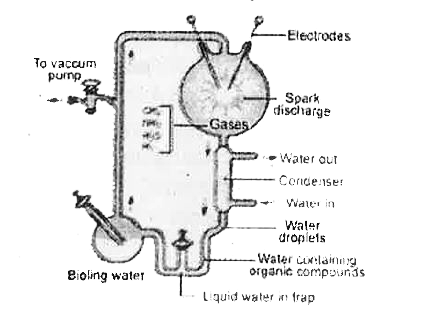Name the gases that were found in primitive earth's atmosphere.
Step-by-Step Text Solution:
1. Understanding Primitive Earth: The Earth is estimated to be around 4.5 billion years old. In its initial phase, the surface of the Earth was molten and did not have a stable atmosphere.
2. Formation of Gases: As the molten surface cooled down, various gases began to form. The primary gases identified in the primitive atmosphere include:
- Carbon Dioxide (CO2): A significant component of the early atmosphere.
- Water Vapor (H2O): Released as the surface cooled and water began to condense.
- Methane (CH4): Another important gas present in the early atmosphere.
- Ammonia (NH3): Formed during the cooling process.
3. Influence of UV Rays: Ultraviolet (UV) rays from the Sun played a crucial role in transforming some of these gases. For example, UV rays contributed to the breakdown of water vapor and carbon dioxide, leading to the formation of:
- Hydrogen (H2): The lighter hydrogen gas evaporated into space.
- Oxygen (O2): This gas combined with ammonia to form other compounds.
4. Additional Gases: Other gases that were present in the primitive atmosphere included:
- Hydrogen Sulfide (H2S): Formed from the combination of hydrogen and sulfur compounds.
- Hydrogen Cyanide (HCN): Another gas that was present in the early atmosphere.
- Nitrogen (N2): Formed as a result of various chemical reactions occurring in the atmosphere.
5. Conclusion: The primitive Earth's atmosphere was composed of a mixture of gases, including carbon dioxide, water vapor, methane, ammonia, hydrogen sulfide, hydrogen cyanide, and nitrogen.
---
- Carbon Dioxide (CO2): A significant component of the early atmosphere.
- Water Vapor (H2O): Released as the surface cooled and water began to condense.
- Methane (CH4): Another important gas present in the early atmosphere.
- Ammonia (NH3): Formed during the cooling process.
- Hydrogen (H2): The lighter hydrogen gas evaporated into space.
- Oxygen (O2): This gas combined with ammonia to form other compounds.
- Hydrogen Sulfide (H2S): Formed from the combination of hydrogen and sulfur compounds.
- Hydrogen Cyanide (HCN): Another gas that was present in the early atmosphere.
- Nitrogen (N2): Formed as a result of various chemical reactions occurring in the atmosphere.
Topper's Solved these Questions
- BOOK - ICSECHAPTER - EVOLUTIONEXERCISE - PRACTICE QUESTIONS (Short Answer Type-I Questions)18videos
EVOLUTION
- BOOK - ICSECHAPTER - EVOLUTIONEXERCISE - PRACTICE QUESTIONS (Short Answer Type-II Questions)30videos
EVOLUTION
- BOOK - ICSECHAPTER - EVOLUTIONEXERCISE - COMPETITION CORNER (Assertion and Reason Type Questions (For AIIMS aspirants))26videos
EVOLUTION
- BOOK - ICSECHAPTER - ENVIRONMENTAL ISSUESEXERCISE - COMPETITION CORNER (ASSERTION AND REASON TYPE QUESTIONS (FOR AIIMS ASPIRANTS))9videos
ENVIRONMENTAL ISSUES
- BOOK - ICSECHAPTER - HUMAN HEALTH AND DISEASE EXERCISE - COMPETITION CORNER (OBJECTIVE TYPE QUESTIONS) (Assertion and Reason Type Questions (For AIIMS aspirants))28videos
HUMAN HEALTH AND DISEASE
Similar Questions
The atmosphere of primitive earth was
View SolutionName the apes which are the most primitive.
View SolutionWhat would have happened if the greenhouse gases were totally missing in the earth’s atmosphere? Discuss.
View SolutionWhich was not present in primitive atmosphere?
View SolutionName the radiations which are absorbed by the green house gases in the earth's atmosphere.
View SolutionBacteria continue to live under conditions which resemble the conditions that prevailed on primitive earth, are
View SolutionAccording to Oparin, which one of the following was not present in the primitive atmosphere of the earth?
View SolutionState the effect of green house gases on the temperature of earth's atmosphere.
View SolutionOzone layer above earth's atmosphere will not
View SolutionIn the experiment in given diagram which of the following groups of gases were used to simulate primitive atmosphere?
 View Solution
View Solution

